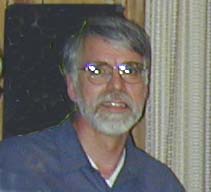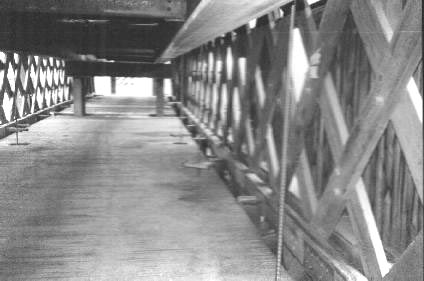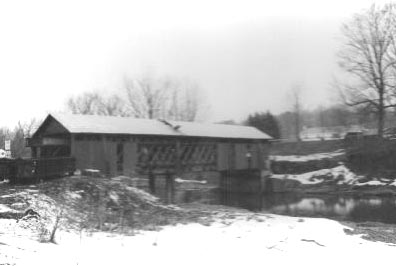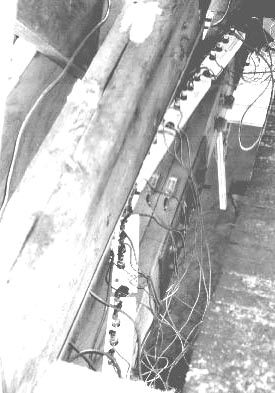delaware
Back to Chronicles
Delaware man dedicated to county's covered
bridges
By Patricia Breakey
Oneonta Daily Star - Delhi News Bureau*
DELHI - Delaware County's deputy commissioner of public works admits he's obsessed
with covered bridges.
Phillip C. Pierce engineered the
restoration of the Hamden Covered Bridge, which is in the final stages, and he has begun work on
Fitch's Bridge in Delhi.
Fitch's Bridge, which spans the West
Branch of the Delaware River, above Delhi, off state Route 10, closed Wednesday and will remain
closed until the restoration is complete. Pierce said if the county's bridge crew could work on the
project full time, the project could be completed in about four months, but because of other
bridge projects, the bridge probably won't be completed until late summer or early fall.
Pierce left the private sector to go to
work for Delaware County in October 1999. He said he was enticed by a promise that he could
work on the restoration of the county's covered bridges.
 Covered Bridge Engineer Phil Pierce while
Covered Bridge Engineer Phil Pierce while
attending VCBS Covered Bridge
Preservation
meeting in Brandon, Vt., Jan. 20, 2001 →
"For the last seven or eight years I have
been obsessed with covered bridge work," Pierce said. "Or maybe its actually more of a
passion."
Pierce has 30 years of experience with
bridge engineering, but in the early 1990s, the company he was working for, McFarland-Johnson
Inc. in Binghamton, was hired by the Vermont Agency of Transportation to do a comprehensive
study of all of Vermont's 75 covered bridges. Pierce conducted the study, wrote up the reports --
and found himself hooked on covered bridges.
Pierce and Wayne Reynolds, Delaware
County DPW commissioner, both worked for McFarland-Johnson 10 years ago and have been
friends since. When Delaware County needed a bridge expert, Reynolds knew who to call.
Nobody is more enthusiastic or knows
more about covered bridges than Phil does," Reynolds said.
Peirce said Fitch's Bridge last had
extensive work in the 70s.
"The bridge is just tired," Peirce said.
"The bracing is leaning badly."
Fitch's Bridge is a Town Lattice truss
bridge. The design was patented in 1820 by builder/architect Ithiel Town. The design consists of a
horizontal top and bottom chord connected by a web of closely spaced, alternating diagonal
timbers. The design, with its inherent strength coupled with its ease of construction, made the
Town lattice truss design a popular design for highway and early railroad bridges until the post
Civil War era.
Pierce said 140 of the. 880 original
covered bridges in existence in the United States are Town lattice bridges.
 Fitches Bridge interior. Photo
Fitches Bridge interior. Photo
taken early in the work.→
Pierce said that former Delaware
County Historian John Raitt supplied him with the history of Fitch's Bridge, which was built in
1870 by James Frazier and Jasper Warren at a cost of $1,970. The single-span bridge of 100 feet
originally spanned the river in the village at Bridge Street and was moved to its present location in
1885.
The bridge was listed on the Historic
Register on April 29, 1999, through the efforts of Trish Kane.
The work on Fitch's Bridge will begin
with a unique study to determine how the structure behaves.
Reynolds said the nondestructive
testing involves attaching diagnostic equipment to the low chord of the bridge, which will produce
a mathematical model to make sure the plans are accurate.
Electrical devices will monitor the
bridge as a known weight travels across it," Reynolds said.
Pierce said the testing is the first of its
type to be done.
 Photo taken from Route 10
Photo taken from Route 10
early in the work →
After the testing in complete, inside
bracing will begin. A temporary structure will be assembled inside the bridge to support it during
the restoration process. Pierce said scrap materials are being used to build the temporary structure
to save the county money.
A few changes will be made in the
bridge to bring it back to its original state.
"The bridge must have been longer
when it was at the original site," Pierce said. "The truss was modified to make it fit, which splayed
the lattice closer together at the ends. The new trusses will be 8 feet longer, which will mean
recasting part of the abutment so the lattice will be parallel. The buttresses, which I call elephant
ears, aren't original and won't be replaced."
The top chord of the bridge will be
preserved, but the two bottom chords and the flooring are all junk, according to Pierce. When the
bridge is complete it will still have 80 percent of its original material.
 Platform for BDI testing
→
Platform for BDI testing
→
The new material will all be sawn. The
chords will be Southern pine and the rest of the new wood will be Douglas fir. Pierce said he
thinks the bridge was originally constructed of local hemlock. The roof will be wood
shingles.
Pierce has been selected by the Federal
Highway Administration to be the principle investigator for a new research project and will
prepare an all-encompassing covered-bridge manual to be published by the federal government.
He said he plans to use knowledge garnered from his work on the restoration of two of Delaware
County's three historic covered bridges in the manual.
For more information about Pierce's
covered bridge projects, visit his website at www.philsbridges.com on the Internet.
 View of bottom chord instrumentation
→
View of bottom chord instrumentation
→
There is also extensive information
about projects Pierce was involved with in Vermont and about the renovation of the Hamden
Covered Bridge at www.vermontbridges.com.
The New York Covered Bridge
Society's website has photos of the Delaware County bridges before they were restored at
www.nycoveredbridges.org.
This article appears here with the kind permission of the Oneonta Daily Star for which we
of the Vermont Covered Bridge Society are grateful.
Return to top
 Joe Nelson, P.O Box 267, Jericho, VT 05465-0267, jcnelson@together.net
Joe Nelson, P.O Box 267, Jericho, VT 05465-0267, jcnelson@together.net
No part of this web site page may be reproduced without the written permission of Joseph C.
Nelson and The Oneonta Daily Star
Text Copyright © 2001, Oneonta Daily Star
Copyright © 2001, Phillip C. Pierce
This file posted April 17, 2001
 Covered Bridge Engineer Phil Pierce while
Covered Bridge Engineer Phil Pierce while Covered Bridge Engineer Phil Pierce while
Covered Bridge Engineer Phil Pierce while Fitches Bridge interior. Photo
Fitches Bridge interior. Photo Photo taken from Route 10
Photo taken from Route 10 Platform for BDI testing
→
Platform for BDI testing
→ View of bottom chord instrumentation
→
View of bottom chord instrumentation
→ Joe Nelson, P.O Box 267, Jericho, VT 05465-0267, jcnelson@together.net
Joe Nelson, P.O Box 267, Jericho, VT 05465-0267, jcnelson@together.net